What is important to the U.S. Fish and Wildlife Service at Stillwater National Wildlife Refuge and to NDOW at “Carson Lake and Pasture” is not cladocerans and forage fish but big wading birds and ducks. It was the widespread deaths and deformities of birds at Kesterson National Wildlife Refuge that shocked the U.S. Fish and Wildlife Service into action and caught the public’s attention. That hasn’t happened at Stillwater National Wildlife Refuge or “Carson Lake and Pasture”. Nonetheless, the findings of poor water quality and the toxicity results were worrisome. There might be sublethal health effects that could blow up some day. To check, the U.S. Fish and Wildlife Service shot a lot of birds.
Approximately 150 avocets, coots, stilts, and ducks at “Carson Lake and Pasture” were sacrificed for the greater good in 1986-1989 (assuming liver, muscle, and skin samples came from the same birds). Additional birds were collected from Stillwater Wildlife Management Area, Fernley Wildlife Management Area, Humboldt Wildlife Management Area, Mahala Slough, and Massie Slough (Hoffman and others, 1990; Rowe and others, 1991). Bird eggs were also collected. 150 birds is less than 0.5% of the 1973-1992 average Nevada-wide duck take of 34,889 (Hogan and Smucker, 1994, p. 71). Hoffman and others (1990) and Rowe and others (1991) reported the concentrations of some 20 trace elements in the bird samples and in a variety of plants and other animals collected in the vicinity of “Carson Lake and Pasture”. Only arsenic, boron, mercury, and selenium are discussed here although other elements of potential concern also have high concentrations in drain and lake waters. No biological samples were analyzed for lithium or uranium. Hoffman and others (1990, Table 7, p. 26) did not list adverse effect levels for lithium, molybdenum, strontium, or uranium in animal tissues or in animal diets.
Algae, pondweed, alkali bulrush, cattail, insects of the order Diptera (probably chironomids), and insects of the sub-order Heteroptera (probably water boatmen, family Corixidae, but possibly backswimmers, family Notonectidae, Tuttle and others, 2000, p. 41-42) carp, mosquito fish, and sacramento perch were collected to determine if trace element concentrations were high in the diets of birds. Game fish have been extirpated from “Carson Lake” waters but forage fish were collected in addition to birds.
Both livers and muscles of birds were analyzed. Livers have higher concentrations of most potentially harmful trace elements than other tissues do and, consequently, slightly better precision. For example, at “Carson Lake” mallard livers had a mean selenium concentration of 3.90 ppm (dry) (n=14, median=4.18, range 1.60-6.62 ppm) and mallard muscle had a mean selenium concentration of 1.04 ppm (dry) (n=10, median=0.99, range 0.50-1.50 ppm, Rowe and others, 1991) Shovelers had livers with mean selenium concentration of 7.96 ppm (dry) (n=10, median=7.50, range 2.80-14.0 ppm) and muscles with mean selenium concentration of 1.23 ppm (dry) (n=30, median=1.10, range 0.37-2.70 ppm, Rowe and others, 1991). For statistical significance, note that the ranges in livers and muscles do not overlap for either species.
Trace-element data for biota are reviewed for drains and for “Sprig Pond”, the Islands Unit, and the Sump at “Carson Lake” separately here to avoid obscuring any geographic variations in biological effects. As the Sump is where the final evaporation of water occurs, it might have the worst water quality and the worst affect on birds.
The Effects of Water Quality on Wildlife at “Carson Lake” – top
Starting with mercury and selenium in drains, the graph of Mercury and Selenium Concentrations in Biota of Drains near “Carson Lake” makes a good case for biomagnification. Both mercury and selenium generally increase up the food chain from algae to bird liver. The few Hemiptera analyses fall somewhere in between while the Diptera analysis has a selenium concentration greater than most bird livers. The forage fish have lower mercury concentrations than the birds. Almost all the vegetation and insect results are below mercury and selenium effects thresholds for the diets of birds. The fish results plot below but the 2 mallard muscle analyses plot above and below the threshold for human aquatic food. The mallard sample with the higher mercury concentration is plotted at 0.1 ppm selenium because selenium was below the detection limit.
___Hg duck diet – 3 ppm (dry): “a dietary concentration associated with reduced reproduction in a single generation of black ducks and lesions in nerve tissue of hatchlings”; 1.1 ppm is “associated with histopathology in bird species”; 0.5 ppm leads to “reduced reproduction in successive generations of mallards” (Tuttle and others, 2000, p. 34).
___Hg human aquatic food – 3.6 ppm (dry): the European Union Commission Regulation (EC) No 1881/2006 of 19 December 2006 (see Annex, Section 3. Metals, Item 3.3 Mercury) sets a maximum allowable level of mercury in some fish and crustaceans of 1 ppm (wet) and 0.5 ppm (wet) for others; 1 ppm measured in a sample that hasn’t been dried is equivalent to 3.6 ppm in a sample that has been dried prior to analysis (most animals have moisture contents of 70-75%).
___Se bird/fish diet – 3 ppm (dry): “food-chain organisms containing 3 ppm dry weight or more should be viewed as potentially lethal to fish and aquatic birds that consume them” (Lemly, 1997, p. 429).
___Se fish tissue – 8 ppm (dry): “biological effects thresholds (dry weight) for the health and reproductive success of freshwater and anadromous fish” is 4 ppm whole-body and 8 ppm in skeletal muscle (Lemly, 1997, p. 429).
___Se bird liver – 10 ppm (dry): “effects thresholds for aquatic birds are” 10 ppm in liver (Lemly, 1997, p. 429).
___coot+ liver – includes liver samples of coots and mallards
Data from Hoffman and others, 1990, U.S. Geological Survey, Water-Resources Investigations Report 89-4105; and Rowe and others, 1991, U.S. Geological Survey, Open-File Report 91-185.
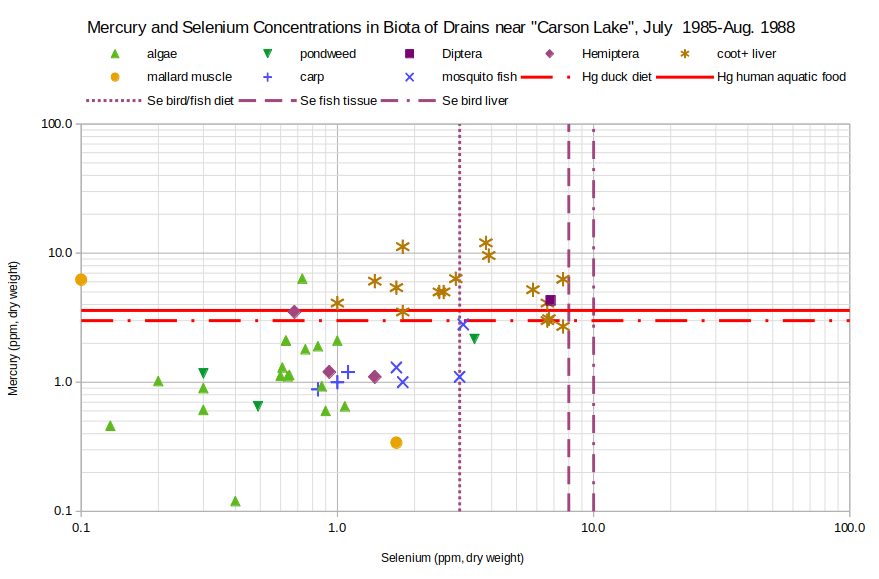
To provide context, the graphs show adverse effects thresholds for mercury and selenium. The maximum mercury concentration allowed by the European Union in fish and shellfish is 3.6 ppm (dry weight) and is shown with the solid red line. All the mercury in fish is considered to be methylmercury. The EU did not impose the same limit on ducks. Because Europeans don’t eat as much duck as fish, ducks are less of a health risk on a population scale. Given evidence that mercury in ducks is dominantly methylmercury (see “3. Wrongly assume ducks have a less harmful form of mercury than fish do” on the How EPA Ducked the Mercury Risks of Ducks at “Carson Lake” page), it would make sense to also consider 3.6 ppm mercury in duck flesh as a lower limit for adverse human health effects. The threshold would be higher for someone who eats less duck than the amount of fish assumed to be consumed in development of the regulation and for someone who weighs more than the assumed weight.
The 3.0 ppm (dry weight) effect level for duck food is based on experimentally observed reduced reproduction and lesions in hatchlings (Tuttle and others, 2000, p. 34). Minor adverse effects were found when ducks were fed a diet with 0.5 ppm (dry weight) methylmercury. Female ducks laid fewer eggs and laid a greater proportion of eggs outside of a nest box (Heinz, 1979). Adult ducks did not get sick or die because of the 0.5 ppm mercury diet.
The reference lines for selenium are based primarily on selenium poisoning events, such as Kesterson National Wildlife Refuge and “Belews Lake” (Lemly, 1997). Although Lemly (1997) did not give an adverse effect threshold for bird muscle, it is probably a good guess to infer that it is less than half the 10 ppm threshold for liver given the medians for selenium in liver and muscle cited above for mallards and shovelers differed by more than a factor of 4.
The Effects of Water Quality on Wildlife at “Carson Lake” – top
Biomagnification can’t be established on the graph of Mercury and Selenium Concentrations in Biota of “Sprig Pond”, “Carson Lake”, because there are so few analyses of plants. The insects have higher mercury concentrations than their counterparts in the drains, as do the carp. The 1 analysis of sacramento perch exceeds the safe level for human food. It looks like slightly less than half of the bird muscle samples have mercury concentrations that would not be safe to eat. Unlike in the drains, several bird liver analyses exceed the level of selenium above which adverse effects would be expected. Avocets and black-necked stilt livers are distinguished from those of coots and ducks as the former have consistently higher selenium concentrations.
___Hg duck diet – 3 ppm (dry): “a dietary concentration associated with reduced reproduction in a single generation of black ducks and lesions in nerve tissue of hatchlings”; 1.1 ppm is “associated with histopathology in bird species”; 0.5 ppm leads to “reduced reproduction in successive generations of mallards” (Tuttle and others, 2000, p. 34).
___Hg human aquatic food – 3.6 ppm (dry): the European Union Commission Regulation (EC) No 1881/2006 of 19 December 2006 (see Annex, Section 3. Metals, Item 3.3 Mercury) sets a maximum allowable level of mercury in some fish and crustaceans of 1 ppm (wet) and 0.5 ppm (wet) for others; 1 ppm measured in a sample that hasn’t been dried is equivalent to 3.6 ppm in a sample that has been dried (most animals have moisture contents of 70-75%).
___Se bird/fish diet – 3 ppm (dry): “food-chain organisms containing 3 ppm dry weight or more should be viewed as potentially lethal to fish and aquatic birds that consume them” (Lemly, 1997, p. 429).
___Se fish tissue – 8 ppm (dry): “biological effects thresholds (dry weight) for the health and reproductive success of freshwater and anadromous fish” is 4 ppm whole-body and 8 ppm in skeletal muscle (Lemly, 1997, p. 429).
___Se bird liver – 10 ppm (dry): “effects thresholds for aquatic birds are” 10 ppm in liver (Lemly, 1997, p. 429).
___coot/duck liver – includes liver samples of coots, mallards, redheads, cinnamon teals, and ruddy ducks
___duck muscle – includes muscle samples of mallards, shovelers, and green-winged teals
Data from Hoffman and others, 1990, U.S. Geological Survey, Water-Resources Investigations Report 89-4105; and Rowe and others, 1991, U.S. Geological Survey, Open-File Report 91-185.
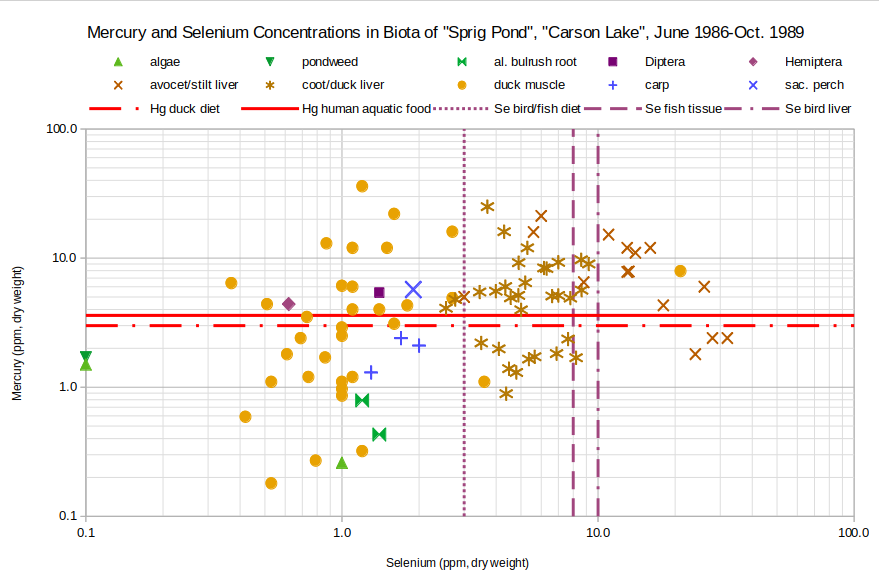
At the Islands Unit of “Carson Lake” (see graph of Mercury and Selenium Concentrations in Biota of Islands Unit, “Carson Lake”), the carp and mosquito fish are doing fine but mercury concentrations in birds are somewhat higher than in “Sprig Pond”. Almost all of the highest mercury concentrations are in samples of shovelers, including the highest liver concentration at 140 ppm and the highest muscle concentration at 55.7 ppm. Fewer of the bird liver analyses exceed the liver effect level for selenium.
___Hg duck diet – 3 ppm (dry): “a dietary concentration associated with reduced reproduction in a single generation of black ducks and lesions in nerve tissue of hatchlings”; 1.1 ppm is “associated with histopathology in bird species”; 0.5 ppm leads to “reduced reproduction in successive generations of mallards” (Tuttle and others, 2000, p. 34).
___Hg human aquatic food – 3.6 ppm (dry): the European Union Commission Regulation (EC) No 1881/2006 of 19 December 2006 (see Annex, Section 3. Metals, Item 3.3 Mercury) sets a maximum allowable level of mercury in some fish and crustaceans of 1 ppm (wet) and 0.5 ppm (wet) for others; 1 ppm measured in a sample that hasn’t been dried is equivalent to 3.6 ppm in a sample that has been dried (most animals have moisture contents of 70-75%).
___Se bird/fish diet – 3 ppm (dry): “food-chain organisms containing 3 ppm dry weight or more should be viewed as potentially lethal to fish and aquatic birds that consume them” (Lemly, 1997, p. 429).
___Se fish tissue – 8 ppm (dry): “biological effects thresholds (dry weight) for the health and reproductive success of freshwater and anadromous fish” is 4 ppm whole-body and 8 ppm in skeletal muscle (Lemly, 1997, p. 429).
___Se bird liver – 10 ppm (dry): “effects thresholds for aquatic birds are” 10 ppm in liver (Lemly, 1997, p. 429).
___coot/duck liver – includes liver samples of coots, mallards, shovelers, and redheads
___duck muscle – includes muscle samples of mallards, shovelers, and redheads
Data from Hoffman and others, 1990, U.S. Geological Survey, Water-Resources Investigations Report 89-4105; and Rowe and others, 1991, U.S. Geological Survey, Open-File Report 91-185.
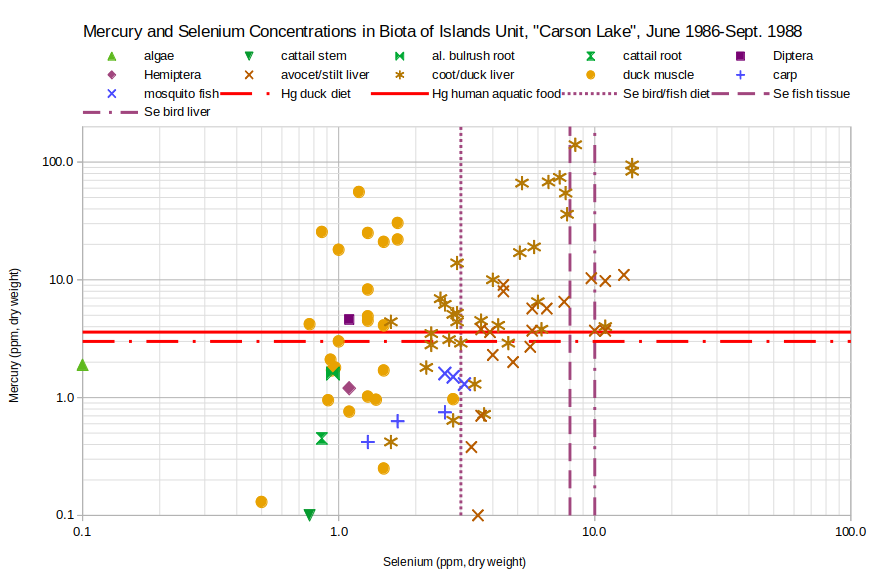
The small number of analyses for the Sump (see graph of Mercury and Selenium Concentrations in Biota of Sump, “Carson Lake”) make comparisons tenuous. What is most striking is the low concentrations of mercury in duck muscle. Liver concentrations are also rather low with none above 10 ppm. This may be at least partly due to the fact that the only ducks shot at the Sump were redheads and they have rather low mercury concentrations at the other sites as well. The 2 insect analyses have lower concentrations of mercury and selenium than those at “Sprig Pond”. Selenium concentrations in avocet and stilt livers do not reach the extremes seen at “Sprig Pond” but that may be due to the smaller sample size. Whether trace element concentrations of biota at the Sump are significantly worse than elsewhere in “Carson Lake” remains to be determined.
___Hg duck diet – 3 ppm (dry): “a dietary concentration associated with reduced reproduction in a single generation of black ducks and lesions in nerve tissue of hatchlings”; 1.1 ppm is “associated with histopathology in bird species”; 0.5 ppm leads to “reduced reproduction in successive generations of mallards” (Tuttle and others, 2000, p. 34).
___Hg human aquatic food – 3.6 ppm (dry): the European Union Commission Regulation (EC) No 1881/2006 of 19 December 2006 (see Annex, Section 3. Metals, Item 3.3 Mercury) sets a maximum allowable level of mercury in some fish and crustaceans of 1 ppm (wet) and 0.5 ppm (wet) for others; 1 ppm measured in a sample that hasn’t been dried is equivalent to 3.6 ppm in a sample that has been dried (most animals have moisture contents of 70-75%).
___Se bird/fish diet – 3 ppm (dry): “food-chain organisms containing 3 ppm dry weight or more should be viewed as potentially lethal to fish and aquatic birds that consume them” (Lemly, 1997, p. 429).
___Se fish tissue – 8 ppm (dry): “biological effects thresholds (dry weight) for the health and reproductive success of freshwater and anadromous fish” is 4 ppm whole-body and 8 ppm in skeletal muscle (Lemly, 1997, p. 429).
___Se bird liver – 10 ppm (dry): “effects thresholds for aquatic birds are” 10 ppm in liver (Lemly, 1997, p. 429).
Data from Hoffman and others, 1990, U.S. Geological Survey, Water-Resources Investigations Report 89-4105; and Rowe and others, 1991, U.S. Geological Survey, Open-File Report 91-185.
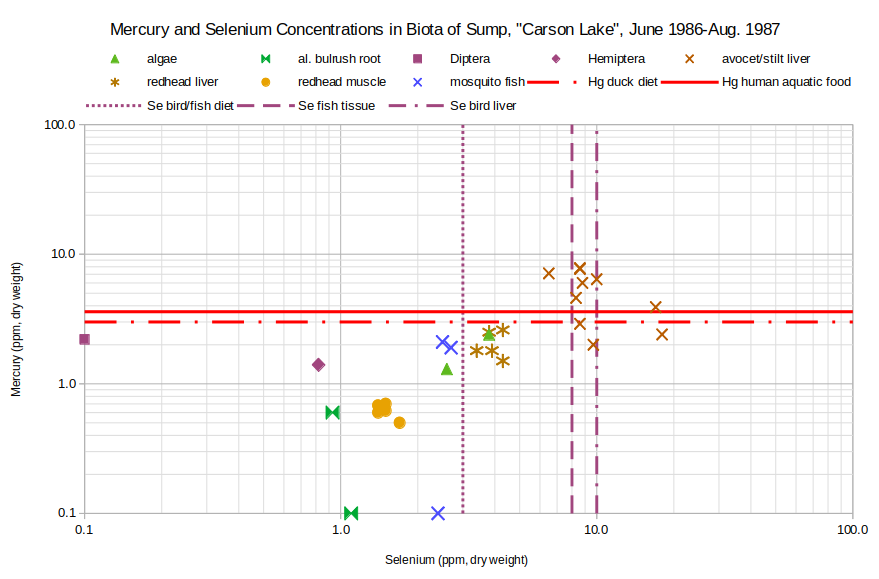
The Effects of Water Quality on Wildlife at “Carson Lake” – top
The analyses of Hoffman and others (1990) and Rowe and others (1991) show that elevated mercury and selenium contaminations are pervasive in the aquatic plants and animals of “Carson Lake and Pasture” in spite of generally low concentrations in shallow ground water and drain water. Low mercury concentrations in water and high concentrations in birds are the definition of bioaccumulation and higher concentrations in consumers than in their diet items indicates biomagnification (see glossary of Hoffman, 1994). These processes intensify the harm due to even low levels of mercury or selenium in the environment. Concentration ranges of up to 3 orders of magnitude (1,000 times) indicate huge variability between individuals that is not easily explained and complicates assessments of ecosystem risk.
The mercury results of the 1986-1989 period were not flukes. Tuttle and others (2000) did not sample algae, dipterans, or duck muscle, focused most of their sampling on the Stillwater National Wildlife Refuge, and presented only geometric means and ranges for their results but that is sufficient to show mercury concentrations are persistently elevated in animals from “Sprig Pond”. Although there are large year-to-year differences for samples collected in 1994, 1995, and 1996, mercury concentrations in hemipterans were all above 1.0 ppm and up to 10.8 ppm, concentrations in fish were all above 2.0 ppm and up to 4.5 ppm, concentrations in coot livers were all above 3.6 ppm and up to 32.2 ppm, and concentrations in avocet livers were all above 2.3 ppm and up to 25.9 ppm (Tuttle and others, 2000, p. 35).
In contrast, selenium concentrations moderated from the 1986-1989 period. None of the analyses of avocet or coot liver exceeded 10 ppm in 1994-1996. The 3-year range was 1.6-8.8 ppm.
Arsenic and boron show very different patterns than mercury and selenium. In the drains (see graph of Arsenic and Boron Concentrations in Biota of Drains near “Carson Lake”), numerous vegetation concentrations were uniformly more than a factor of 4 (boron) or 20 (arsenic) higher than concentrations in coot and a few mallard livers. 73% of bird liver analyses were below the detection limit for arsenic (some have the same boron concentrations and plot on top of each other). Insect analyses fell in between. This is the opposite of biomagnification. This is the case even though several concentrations of boron in vegetation and a few concentrations of arsenic in vegetation were above the diet thresholds for adverse effects in birds. Boron concentrations in mosquito fish and carp were either below detection or not determined but are plotted at 1.0 ppm boron to show the arsenic concentrations.
___As fish level – 4.68 ppm (dry): tissue level in fish above which adverse effects would be expected (Hoffman and others, 1990, p. 26).
___As bird diet – 30.0 ppm (dry): level in food that may have adverse effects on birds (Hoffman and others, 1990, p. 26).
___B bird diet – 108 ppm (dry): level in food that may have adverse effects on birds (Eisler, 1990, p. 27).
___coot+ liver – includes liver samples of coots and mallards
Data from Hoffman and others, 1990, U.S. Geological Survey, Water-Resources Investigations Report 89-4105; and Rowe and others, 1991, U.S. Geological Survey, Open-File Report 91-185.
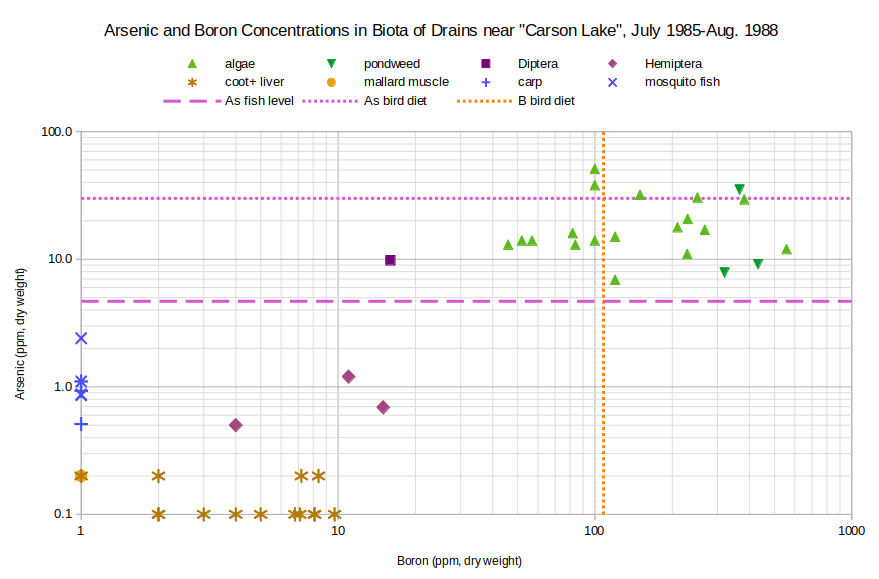
The bioreduction pattern continues at “Sprig Pond” (see graph for Arsenic and Boron Concentrations in Biota of “Sprig Pond” at “Carson Lake”). All 3 algae and the 1 pondweed analysis have boron concentrations greater than the adverse effect threshold for bird diets. All but 3 of the bird liver samples have concentrations that are lower by a factor of 2. Arsenic concentrations are a factor of at least 3 higher in plants and insects than in bird livers. As a reminder, arsenic concentrations in water did not correlate with mortality in the toxicity tests (Toxicity of Newlands Drain Water). This bioreduction may help explain why.
___As bird diet – 30 ppm (dry): level in bird diet that may have adverse effects (Hoffman and others, 1990, p. 26).
___As fish level – 4.68 ppm (dry): the tissue level that may adversely affect fish (Hoffman and others, 1990, p. 26).
___B bird diet – 108 ppm (dry): level in waterfowl food that may have adverse effects is 30-100 ppm, wet weight (Eisler, 1990, p. 27); 30 ppm wet weight is equivalent to 108 ppm dry weight.
___coot+ liver – includes liver samples of coots and mallards
Data from Hoffman and others, 1991, U.S. Geological Survey, Water-Resources Investigations Report 89-4105; and Rowe and others, 1989, U.S. Geological Survey, Open-File Report 91-185.

The Effects of Water Quality on Wildlife at “Carson Lake” – top
Bird livers at the Islands Unit have generally lower arsenic concentrations than those at “Sprig Pond” but somewhat higher boron concentrations. The arsenic concentrations of Diptera, Hemiptera, and cattail root were all less than those at “Sprig Pond”. At the same time, the algae analysis scored an arsenic record for plants. The boron results suggest 2 distinct populations of birds: those with boron concentrations in liver of 40-180 ppm and those with boron concentrations in liver of below detection to 10 ppm. This raises the possibility that small areas within “Carson Lake” have very different concentrations of trace elements in bird food. The same pattern is less well defined at “Sprig Pond” where 3 liver samples fall within the 10-40 ppm gap. The 2 mosquito fish analyses for the Islands Unit continue the trend of low arsenic and boron concentrations in fish. They have boron below the detection limit and arsenic concentrations of only 0.25 ppm.
___As bird diet – 30 ppm (dry): level in bird diet that may have adverse effects (Hoffman and others, 1990, p. 26).
___As fish level – 4.68 ppm (dry): the tissue level that may adversely affect fish (Hoffman and others, 1990, p. 26).
___B bird diet – 108 ppm (dry): level in waterfowl food that may have adverse effects is 30-100 ppm, wet weight (Eisler, 1990, p. 27); 30 ppm wet weight is equivalent to 108 ppm dry weight.
___coot+ liver – includes liver samples of coots and mallards
Data from Hoffman and others, 1991, U.S. Geological Survey, Water-Resources Investigations Report 89-4105; and Rowe and others, 1989, U.S. Geological Survey, Open-File Report 91-185.
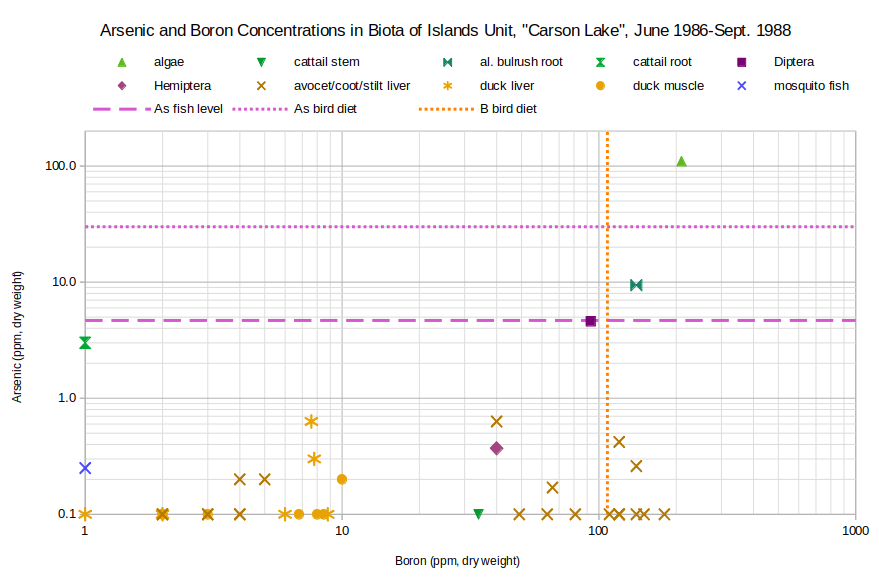
Whatever happens at the Sump (or happened in 1986-1987), it’s a great way to reduce arsenic concentrations in bird livers and muscles. Only 2 of 18 analyses had arsenic above the detection limit. This is true even though food chain concentrations of arsenic are at least a factor of 4 higher. Boron concentrations of biota at the the Sump other than fish are somewhat higher than those at the other 3 “Carson Lake” localities. There are no bird livers with boron below the detection limit and the Sump has the highest boron concentration in bird liver. In shallow ground water, the strong correlation of boron with chloride indicates it is strongly concentrated by evaporation. It can be enriched by over 100 times compared to “Lahontan Reservoir” water. Higher biota concentrations of boron at the Sump may reflect this.
___As bird diet – 30 ppm (dry): level in bird diet that may have adverse effects (Hoffman and others, 1990, p. 26).
___As fish level – 4.68 ppm (dry): the tissue level that may adversely affect fish (Hoffman and others, 1990, p. 26).
___B bird diet – 108 ppm (dry): level in waterfowl food that may have adverse effects is 30-100 ppm, wet weight (Eisler, 1990, p. 27); 30 ppm wet weight is equivalent to 108 ppm dry weight.
___coot+ liver – includes liver samples of coots and mallards
Data from Hoffman and others, 1991, U.S. Geological Survey, Water-Resources Investigations Report 89-4105; and Rowe and others, 1989, U.S. Geological Survey, Open-File Report 91-185.
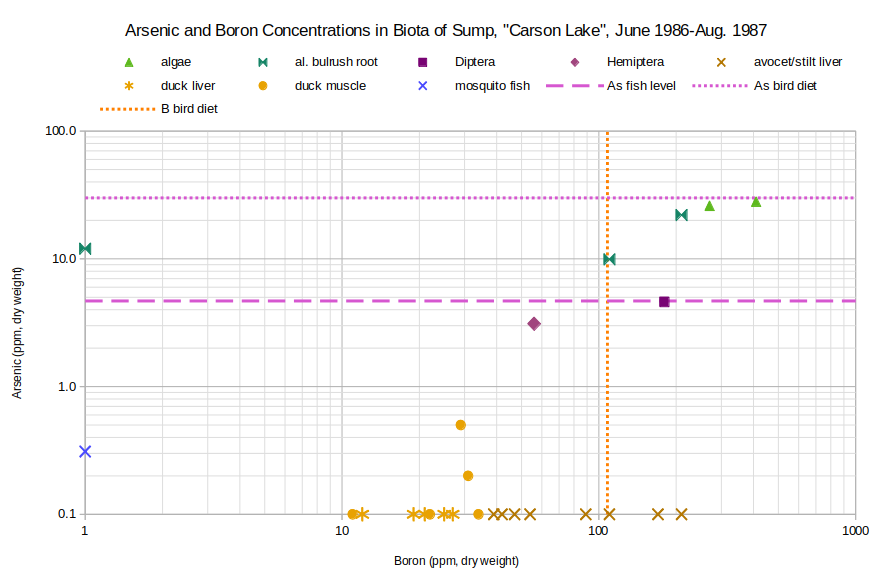
Toxicity tests showed that some of the surface waters are toxic to Daphnia magna, bluegills, fathead minnow larvae, and striped bass. The more toxic waters generally had higher concentrations of TDS and of many trace elements that are also enriched by evapotranspiration. Even with evaporative enrichment, absolute concentrations of most trace elements were still quite low relative to adverse effect levels documented in the scientific literature. However, a few water samples exceeded aquatic life standards for arsenic or boron. Some algae and pondweed analyses had concentrations above adverse effect levels in bird diets for boron and, rarely, arsenic. Paradoxically, potentially harmful concentrations of arsenic and boron were not found in bird or fish tissues.
The Effects of Water Quality on Wildlife at “Carson Lake” – top
Instead, it appears that mercury and selenium pose the greatest threats to vertebrate animal health in spite of their low concentrations in ground and surface waters. No drain or lake waters in or upstream of “Carson Lake and Pasture” were found to have selenium or mercury concentrations above the chronic aquatic life standards of the U.S. Environmental Protection Agency. Concentrations in food-chain plants and animals also do not appear to be particularly concerning. Only 2 of 27 algae and pondweed samples had selenium concentrations above the effect level for bird and fish diets and only 1 of the samples had a mercury concentration above the duck diet threshold. Of 10 aquatic insect samples, 5 had more mercury than the duck diet effect level and 1 had more selenium than the corresponding selenium level for bird diet. Yet, 84% of bird liver analyses (n=126) analyzed in 1987-1989 had selenium concentrations above adverse effect levels. The same may be true of mercury but if there is a widely accepted adverse effect level for mercury in bird liver, I haven’t found it. 65% of the liver concentrations (n=126) were above the methylmercury standard for human food. 1 of 1 sacramento perch also had a mercury concentration above the methylmercury standard although none of the carp or mosquito fish did.
Widespread bird or fish deaths due to elevated trace element concentrations have not been documented at Stillwater National Wildlife Refuge or “Carson Lake and Pasture” (i.e., they are not mentioned by Tuttle and others, 2000). The summary of Hallock and Hallock (1993, p. 72) indicated that no teratogenesis had been observed in waterfowl embryos or hatchlings and that hatching rates were normal. Henny and others (2000) took another look and their results can be summarized as follows.
- Mercury: 5.5% (n=228 excluding Massie Slough and Humboldt/Toulon) of duck eggs, 0 eared grebe eggs (n=67), and 14% (n=247 excluding Massie Slough and Humboldt/Toulon) of “other water birds” eggs had concentrations exceeding 3 ppm mercury, which has the “potential for adverse effects on eggs based upon our review of the literature” (p. 61).
- Selenium: less than 1% (n=228 excluding Massie Slough and Humboldt/Toulon) of waterbird eggs had selenium concentrations higher than 6 ppm (Table 24, p. 54.5), “which is the lowest known effect level reported (for black-necked stilts) for reduced reproductive success” (p. 66).
- Boron: 1 coot egg out of about 200 had a boron concentration greater than 38 ppm, which is a level that “showed reduced hatching success” in laboratory studies (p. 67).
- Out of hundreds of eggs collected over 3 years at Stillwater National Wildlife Refuge, “Carson Lake”, and “Sheckler Reservoir”, only 1 embryo was found with a deformity and the concentrations of mercury (0.3 ppm (dry), selenium (0.8 ppm dry), and boron (3.5 ppm dry) were considered too low to have been responsible (p. 67).
That doesn’t mean all is well. “Lead Lake has a history of avian botulism and unexplained fish and migratory bird deaths, and most of the emergent vegetation has perished in the last 30 years” (Hallock and others, 1993, p. 39). “Concentrations of agricultural-drainage-related trace elements found in Lahontan Valley are within the range of concentrations associated with a variety of direct and indirect effects on fish and wildlife, including altered behavior; biochemical and histological effects, immunosuppression; decreased reproduction, malformation of embryos, and mortality” [internal citations omitted] (Tuttle and others, 2000, p. 40).
Instead of causing observable sickness, deformity, or death in vertebrates, the effects of the poor quality of Newlands irrigation water have operated more at the ecosystem level and principally on invertebrates and plants. For example, “Lead Lake” generally has poorer water quality than “Stillwater Point Reservoir” (see Fathead Minnow Toxicity Profiles of Drains Upstream of and Within Stillwater National Wildlife Refuge, August 1987 on the Toxicity of Newlands Drain Water page) and also has lower species richness, evenness, and heterogeneity in bottom-dwelling invertebrates and lower species richness and heterogeneity in swimming invertebrates (Tuttle and others, 2000, p. 41-42). “Aquatic-invertebrate communities in Lahontan Valley wetlands, particularly in Lead Lake and Sprig Pond, exhibited some characteristics consistent with impaired stream systems, including absence of sensitive taxa, dominance of tolerant taxa, and low taxa richness” (Tuttle and others, 2000, p. 55).
Sensitive plant species have decreased in abundance at Stillwater Marsh. Cattails “are now found only in scattered patches” (Kerley and others, 1993, 18). Coontail and horned pondweed have also declined. Species more tolerant of high TDS, such as widgeon grass and sago pondweed, have increased in abundance.
The Effects of Water Quality on Wildlife at “Carson Lake” – top
Mass fish deaths due to normal irrigation drainage haven’t been reported but fish communities have problems similar to those of invertebrate communities. “Fish communities in these wetlands possess many of the characteristics of a degraded fishery, including limited species diversity, predominance of tolerant species, skewed trophic structure, and lack of piscivorous fishes” in addition to ages skewing young (Tuttle and others, 2000, p. 55). “Sprig Pond” may be the most affected. Of all the fish sampling sites, “Sprig Pond” yielded the smallest number of fish despite “more-intensive” efforts (Tuttle and others, 2000, p. 44). Moreover, it had only carp in 1995-1996 whereas tui chub and pumpkinseed were present at all 3 sites on the Stillwater National Wildlife Refuge and fathead minnow at 2 (Tuttle and others, 2000, Table 20, p. 47). Introduced largemouth bass once thrived at “Carson Lake” but the population “virtually disappeared” in the 1970s (Kerley and others, 1993, p. 19).
Kerley and others (1993, p. 19) noted that clams and snails were commonly observed at “Carson Lake” in 1876 and 1885 and were common in a 1929 survey of Fallon National Wildlife Refuge. Frogs were also present at Fallon National Wildlife Refuge. Mink, river otters, and muskrats were well known to the Paiutes in the late 1800s. Mink, otters, frogs, and turtles are now absent from wetlands in the Carson Desert and muskrats, clams, and snails are no longer abundant. Remnant populations of clams have survived in waters with the lowest TDS concentrations, such as “Stillwater Point Reservoir” and D-Line Canal (Kerley and others, 1993, p. 19).
No direct effects of poor water quality on birds have been observed but the potential is there. “Aluminum, boron, and mercury in avian food chains were found to exceed concentrations associated with sublethal effects, and 5 percent exceeded levels associated with embryotoxicity. Boron concentrations in a majority of the sampled eggs exceeded concentrations associated with sublethal effects” (Tuttle and others, 2000, p. 55). Although “Aquatic-bird occurrence, nesting, and reproduction have declined since the beginning of the Newlands Project”, that is primarily due to loss of habitat (Tuttle and others, 2000, p. 55).
The 2008 brochure for Stillwater National Wildlife Refuge does not mention decreased bird species richness, evenness, or heterogeneity. Rather, it proclaims:
“More than 290 [bird] species have been sighted in the area. Its tremendously rich and diverse wetlands attract more than a quarter million waterfowl, as well as over 20,000 other water birds, including American white pelicans, double-crested cormorants, white-faced ibis and several species of egrets, herons, gulls and terns.”
Bird counts suggest that “Sprig Pond” has plenty of birds. The mean of 5 monthly bird counts in 1996 (10 minutes of observations at each of 5 points at each lake) indicated that “Sprig Pond” had more great egrets (20), white-faced ibis (1,567), and Forster’s terns (19) than “Stillwater Point Reservoir”, “Lead Lake”, and “Dry Lake” and almost all the avocets (1,538) seen at all 4 locations (Tuttle and others, 2000, Table 22, p. 49-52). This is in spite of the fact that “Carson Lake” birds (principally from “Sprig Pond”) have significantly higher mercury concentrations than those at Stillwater National Wildlife Refuge (see “4. Reduce risk by averaging out time, geography, and species” – “Geography” on the How EPA Ducked the Mercury Risks of Ducks at “Carson Lake” page).
Whether or not any birds are suffering from ataxia, memory loss, or reduced learning ability, some duck species from “Carson Lake and Pasture” in some years could give those symptoms to humans who eat them due to their high mercury concentrations (Histogram of Mercury Concentrations in Duck Species from “Carson Lake and Pasture”).
What about fairy shrimp? If increasingly poor water quality at “Carson Lake” eventually killed off all the fish, that could open up new habitat for fairy shrimp. The avocets would be happy to see them. Water quality could be an issue, though. Fairy shrimp are branchiopods like the Daphnia magna that were repeatedly killed off by surface water samples in the experiments of Dwyer and others (1992), Finger and others (1993), and Higgins and Miesner (2002). The fact that the fairy shrimp Thamnocephalus platyurus is used in toxicity tests (see Humans in Predators of Fairy Shrimp) further suggests some fairy shrimp species are sensitive to water quality.
The Effects of Water Quality on Wildlife at “Carson Lake” – top
On the other hand, there is the genus Artemia. Artemia eggs have survived a trip to space (I haven’t found any publicly accessible scientific articles or informative abstracts). There is limited evidence they can tolerate mercury contamination.
Artemia living in “Great Salt Lake” are of interest because they are a major food source for birds and the Utah Department of Health has at times issued health advisories due to mercury contamination of ducks killed there. Unfiltered (i.e., suspended plus dissolved) “open water” samples from Gilbert Bay of “Great Salt Lake” were found to have 5.3 x 10exp-6 mg/L (5.31 nanograms per liter) mercury in the shallow brine layer and 46.6 x 10exp-6 mg/L (46.6 nanograms per liter) in the deep brine layer (Utah Department of Environmental Quality, 2011, p. 15). The only 3 analyses of mercury in unfiltered water samples for “Carson Lake” have much higher concentrations. 2 samples collected from “Carson Lake Drain” on March 13, 1987 and May 14, 1987 had 200 x 10exp-6 mg/L and 2,400 x 10exp-6 mg/L (Hoffman and others, 1990). 1 from “Sprig Pond” on March 17, 1987 had 4,410 x 10exp-6 mg/L total recoverable mercury (Hoffman and others, 1990). The mercury contamination apparently did not affect the Artemia fairy shrimp living in Great Salt Lake although they had measurable concentrations of mercury. 60 adults had a mean total mercury concentration of 0.059 ppm (wet weight basis) (Van Leeuwen and others, 2011, p. 113).
San Francisco Bay also has birds and fish contaminated by mercury and some feed on Artemia. The median dissolved mercury concentration in water collected from the Lower South Bay in San Mateo, Alameda, or Santa Clara counties in 1993-2013 was 1.9 x 10exp-6 mg/L (n=155) (data from the Regional Monitoring Program under the direction of the San Francisco Estuary Institute, which can be downloaded at https://cd3.sfei.org/downloads/). The Lower South Bay dissolved mercury concentration was considerably less than the several 100 to 300 x 10exp-6 mg/L dissolved mercury results for water from “Carson Lake” and upstream drains (Hoffman and others, 1990; Rowe and others, 1991). The South Bay mercury concentration was nonetheless sufficient to contaminate birds to levels similar to those at “Carson Lake”. Black-necked stilts living near salt ponds in the southern part of San Francisco Bay had mercury concentrations of about 15 ppm (“least squares mean”, dry weight basis) in their livers (Ackerman and others, 2014, Figure 32, p. 109). That is higher than the 7.1 ppm median of 29 stilt liver samples collected at “Carson Lake” but within the observed range of 2.7-21.2 ppm (Hoffman and others, 1990; Rowe and others, 1991). Mercury was also found in Artemia of the South Bay but no negative effects were reported. The geometric mean of mercury concentrations in Artemia from stilt foraging sites during the pre-breeding season was found to be 0.31 ppm (dry weight basis) (n=8) (Ackerman and others, 2014, Table 15, p. 192).
Artemia in Dzharylgach, a lake on the Crimean peninsula, had a mercury concentration of 0.318 ppm (318 nanogram per gram) (concentration of a dry bulk sample) in August 2018 when the TDS concentration was 188,000 mg/L (Shadrin and others, 2022, Table 4, p. 11). An undated analysis of water from the same lake yielded a mean dissolved (filtered) mercury concentration of 180 x 10exp-6 mg/L (Shadrin and others, 2022, Table 2, p. 6). That water concentration is considerably higher than those in the South Bay even though the Artemia concentration is about the same. The Dzharylgach dissolved mercury concentration is in the range of the mercury concentrations in “Carson Lake” and upstream drains.
The mercury results for Great Salt Lake, southern San Francisco Bay, and Dzharylgach indicate Artemia can survive a range of mercury concentrations in water, including concentrations up to those observed in “Carson Lake”. Although the waters of “Carson Lake” and Stillwater Marsh do not have TDS concentrations high enough to allow colonization by Artemia, there might be other fairy shrimp species that are similarly resistant to the toxic effects of mercury.
The Effects of Water Quality on Wildlife at “Carson Lake” – top